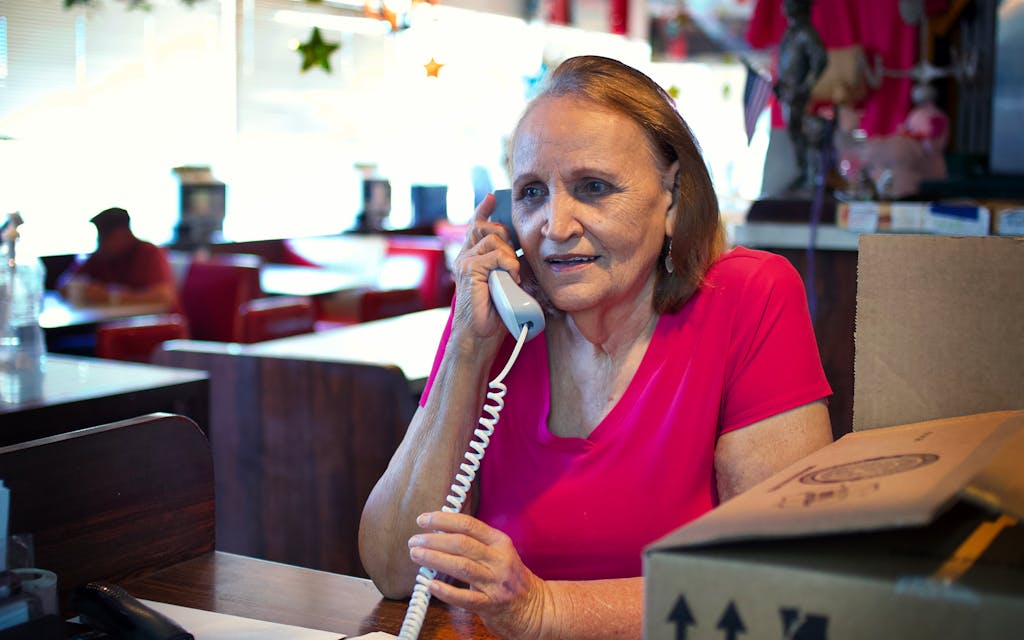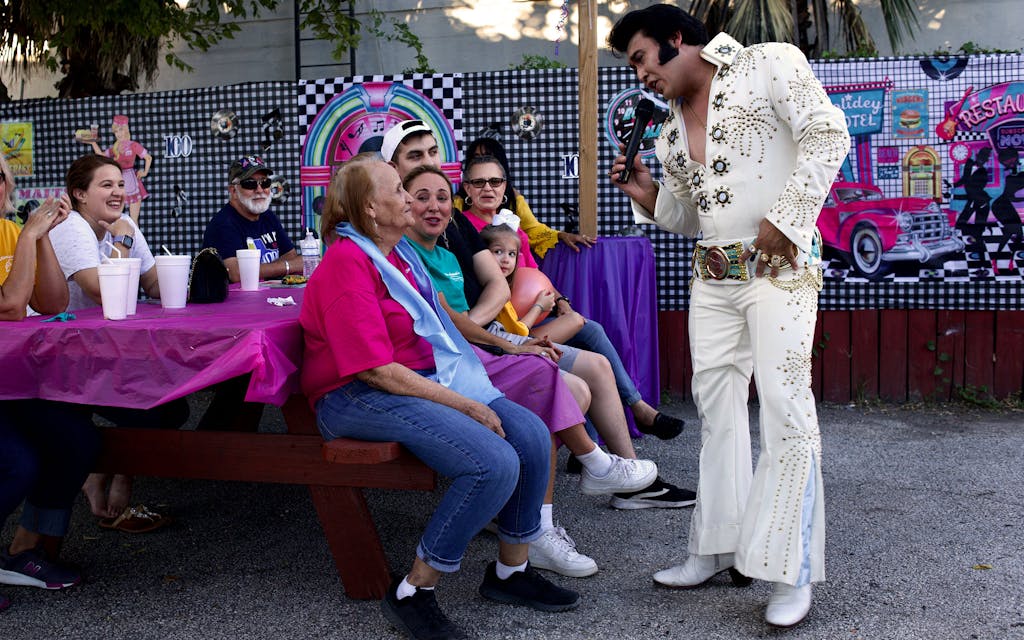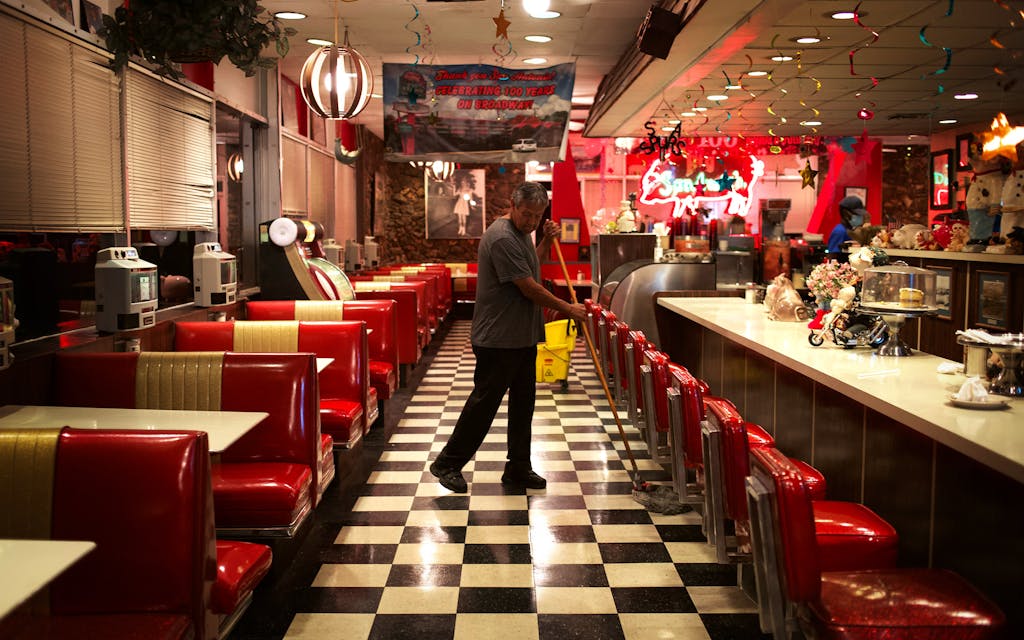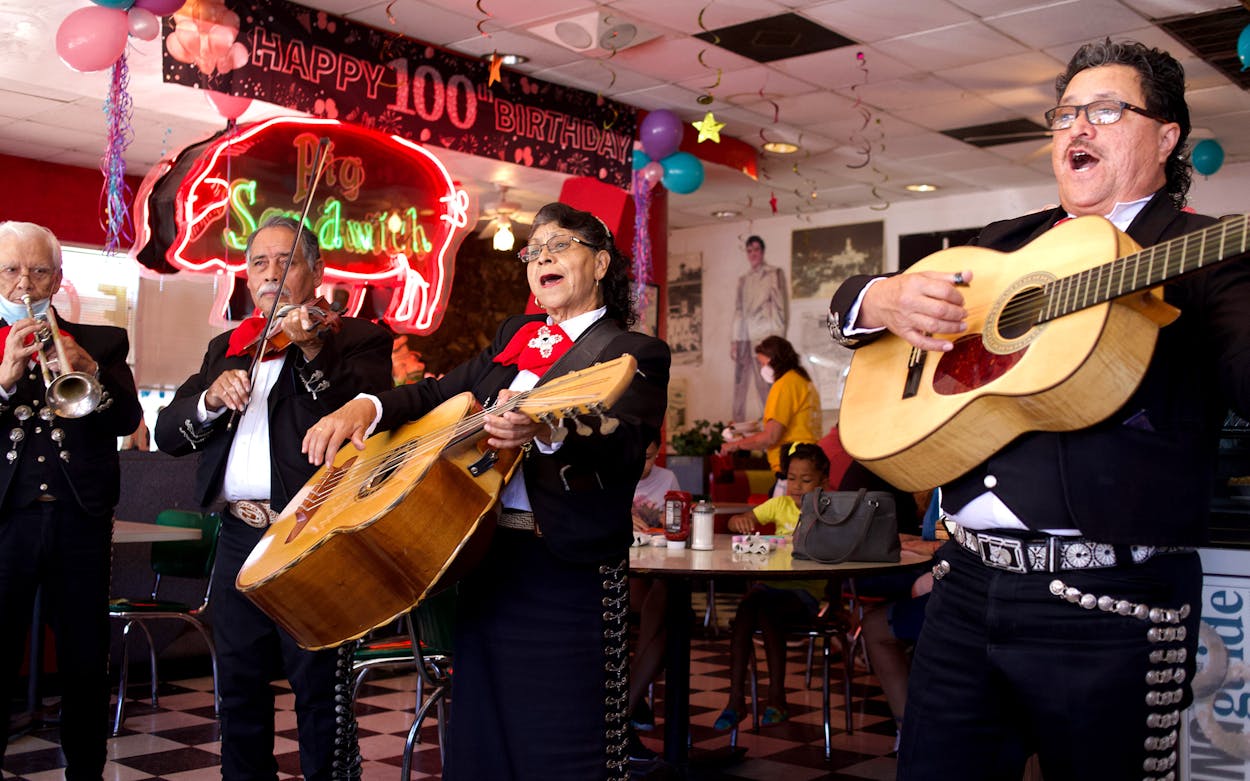The woman on the mural looks straight out of the fifties. She has curly hair, pearl earrings, and a yellow dress with a name tag that reads “Mary Ann.” Facing the parking lot and holding a milkshake, she seems ready to walk off the wall and over to someone’s car.
In front of the mural stands the real Mary Ann, 73. Her face is lined after 54 years of working at the Pig Stand, but her blue eyes are alert as she directs two employees to move a picnic table under the morning sunlight. When several more tables are placed to her satisfaction, she plods toward the restaurant’s back door, lightly touching picnic tables as she goes.
“I do a lot of walking,” she says. “Especially today.”
Today is Saturday, October 9, 2021, and Mary Ann Hill is hosting a party for the hundredth anniversary of the Pig Stand. Founded in 1921 in Dallas, the Pig Stand was America’s first drive-in. At one time, it sold its famous “pig sandwiches” (thick slices of smoked pork with relish and barbecue sauce in a bun) in over a hundred locations across nine states. After decades of slow decline, company bankruptcy forced the last few Pig Stands to close in late 2006. But Hill, the manager of Pig Stand No. 29 in San Antonio, wasn’t ready to admit defeat. With a loan from a customer, she purchased the building and reopened it in early 2007. The Pig Stand has survived since then, even through the coronavirus pandemic.
Over the decades, the Pig Stand at 1508 Broadway has evolved into more than a restaurant—it’s a community hub. It has hosted birthday parties for customers and memorial services for former employees. Classic-car enthusiasts wheel into its parking lot every Friday for meetups. Its interior sometimes serves as a film set for a customer bent on making it big in the movie business. But with Hill getting older and the property owner thinking of selling, Hill isn’t sure how much longer she can keep the community together. The Pearl mixed-use development across the street is an emblem of how much Broadway has changed—and of how progress threatens to swallow up the vintage diner. Today, though, while the Pig still stands, Hill is determined to celebrate the customers and employees who have meant so much to her over the years.

At 8:59 a.m., Hill is mixing cake batter when an employee unlocks the door to let the first customer in. “Morning, Anna,” Hill calls out. “Are you having your usual?” Anna affirms, and Hill calls to the cooks: “Right now I need a ham-and-cheese omelet with hash browns.”
Anna Giron, 64, walks across the black and white checkered floor, past a porcelain menagerie of pigs on the counter and windowsills, to sit at a bright red booth near the jukebox. She often ate at the Pig Stand with her father before his death last summer. Giron glances at her dad’s favorite booth, bathed in the light of a giant, 1920s-era neon sign shaped like a pig. She gestures at the streamers and anniversary banners around the sign. “He would’ve loved this,” she says.
Next to her dad’s booth is a large round table, also empty. A group of retired engineers used to sit there, Giron says. “And then when the COVID came, they stopped coming. And they started dying.”
For a restaurant as old as the Pig Stand, death is a familiar customer. Hill once had a regular named Red, whom everyone called “the Booker” because he placed sports bets. The Booker stopped coming after he got sick, but one night when Hill was at home, she got a call: “The Cowboys are going to win this year,” he told her. “They’re gonna go all the way, and I just wanted to give you a heads up, in case you wanted to bet.” Red continued: “I want to tell you that I truly appreciate you waiting on me all this time.” “Aw, you’re welcome,” Hill remembers saying. “And when you get better, I’ll be there.” “No,” Red said. “I’m calling you to tell you goodbye.” He went on to say he would never forget her. “And he died that night,” Hill recalls.
Hill didn’t bet, and the Cowboys didn’t win. But the Booker remains part of a Pig Stand scrapbook in Hill’s head, an archive of moments and customers she’ll always remember. It takes only the slightest trigger to send her down mazes of memory. “My whole life can flash in front of me, from the time I’ve worked to the days I have right now,” she says.


At the moment, though, she has no time to reminisce. As dishes clatter and the fryer sizzles, Hill finishes the cake batter and enlists a younger employee to help her pour it. Outside, Hill’s daughters and granddaughters help decorate the picnic area with balloons, pink and aqua tablecloths, and fifties-themed banners for the anniversary party at two. They are only a few of the many family members that will show up today—both from Hill’s biological family and from her Pig Stand family of current and former employees.
Inside the restaurant, Hill chats with a frequent visitor named Cole, talking about a customer she spoke with the other day. “He says if they sell the property, he’ll be standing there, begging them not to do it.” Cole laughs: “I know, I know.”
This is just one of many customers Hill has laughed with over the decades. She’s cried with plenty, too. One was a woman who suffered from liver cancer for twenty years. Hill, who has survived cancer twice, always made sure the woman got her fish the way she liked it. “She came in her last time, and she was so weak,” Hill says. “But she wanted to come in and eat fish one more time.” At one point during the meal, the woman became nauseous. Hill walked her to the bathroom, where she vomited up seemingly everything inside her body. When it was over, Hill washed her face.
“You never know when people need someone to care for them,” she says. “Because you don’t know their life at home. . . . You just—you love ’em while you have ’em.”

Shortly before two o’clock, a man in a straw fedora drives up, parks his 1930 Chrysler, and takes a seat at the counter. “How you doin’, mija?” he says to cashier Renee Neilson, who greets him from behind the counter: “Banana split time?” Sixty-five-year-old Josh Alvarado is a regular at the weekly antique-car meetups in the Pig Stand’s parking lot. Every Friday, he eats a giant banana split against the advice of his doctor. “You know, you get old, and then the doctor takes food away from you, or they bypass your stomach, and they have to feed you through a tube . . . and you don’t get no taste out of that stuff,” he says. “So I told them I’m gonna eat what I can.”
Outside, Hill is busy supervising the official kickoff of the party, with pig sliders, root beer floats, cake, a balloon arch, and festively decorated picnic tables. Not long after Hill comes back in, she is greeted by a surprise gift from one of her customers—a mariachi band. Hill stands still, smiling, as they sing “Happy Birthday,” but after that, it’s back to work. During the second song, her attention has already turned to the customers in a nearby booth.
At the counter, a man with a white beard, Yankees cap, and Doctor Who shirt is reading a book about art crime. Paul Fox, 61, can’t afford to come to the Pig Stand very often. This Saturday is an exception. “My cat passed away a year ago today, and I didn’t want to sit around the house,” Fox says. “So I decided to come down. I mean, I’m not really sure how much longer I’m going to be around, or how much longer any of these places are going to be around.”
Of all the lives the Pig Stand has touched, perhaps the most consequential is Hill’s own. She started as a server at age eighteen, a painfully shy girl whose mother talked her into the job. “I was scared to death,” she recalls of her first day. “But there was an old group of coffee drinkers, about eight of ’em. And they said, ‘You’re gonna do just fine; we’re gonna teach you the ropes. And the first thing you need to do is take this’—I can’t remember if it was fifty cents or a quarter—‘and play us some music. And every day you work, that will be your routine. You get our coffee, and then you play us some music.’” Hill had never used a jukebox before, but she learned. The customers of the Pig Stand became like grandparents and parents and siblings to her—and as she got older, she became like a parent and grandparent to them. “I love my family,” she says. “But they became my family too.”
Hill started at a different Pig Stand and moved to the Broadway location in 1970. Originally housed across the street from the current building, Pig Stand No. 29 was leased to a franchisee in 1929. It was one of several Pig Stands in San Antonio, the first of which were founded in the early 1920s. The chain prospered during the automobile boom of the twenties and thirties, with San Antonio ads promising “a tasty meal served at your wheel.” During the World War II worker shortage, the Pig Stands were the only San Antonio drive-ins able to maintain curb service.
But by the time Hill joined the chain, the Pig Stand was in decline. When the company sold off its operations in other states, former carhop Royce Hailey bought the Texas Pig Stands. In his decades with the company, Hailey was credited with inventing Texas Toast and supporting desegregation. “Mr. Hailey was one of the first restaurants to hire Black people,” Hill says. “And they boycotted him. They told him that ‘we’re not coming to eat here anymore until you get rid of those two cooks.’ And then he says, ‘Well, that’s too bad, cause you’re gonna be missing some good food.’”

Hailey’s son later took over, and the Texas joints persisted decades after curb service ended in the eighties. Then a failed 2005 expansion forced the chain into bankruptcy. Days before Thanksgiving of 2006, Richard Hailey called Hill at home and told her he had been given only a few hours to close the restaurants. “I knew things were happening, because managers didn’t get paid,” she recalls about the two months prior. “But I didn’t know things were that bad.”
As soon as Hill got Hailey’s call, she called the manager on duty and told her to lock the doors. Hill went by later to find regulars congregating outside; some were crying. “Don’t cry,” she told them. “I’m sure we’re gonna be back.” She told reporters the same thing. “I didn’t know for sure,” she remembers. “That’s just what I felt, you know.”
The Pig Stand did come back, thanks to a customer who loaned Hill money to buy the building (she paid it all back). Now, over a decade later, the Pig Stand customers bask in the remainder of this afternoon’s activities—a visit from KSAT-TV; the arrival of a DJ, who spins a mix of Tejano and golden oldies; and finally, at six o’clock, a performance by Elvis Presley (a.k.a. impersonator Travis Hudson). Elvis sings day into night, enthralling a crowd of about fifty customers with his melodies as the sun leaves the sky. By the time the performance ends, Freddie Flores, 75, is slow-dancing with his wife under a crescent moon. Flores is legally blind, but he knows where everything in the Pig Stand is—he’s been coming since he was four. He calls Mary Ann “Maria,” and although he can’t see the porcelain pigs, he touches them whenever he comes in.
As closing time approaches, Hill finally allows herself a break. She cuts into one of the cakes she made that morning, and after delivering three chocolate slices to customers, she takes one and adds a scoop of vanilla ice cream. Sitting down at the counter, she chats with Julian, a sixteen-year-old who worked at the Pig Stand for four days last month before he had to move across town. Those four days made such an impression on him that he made the trip here today to help Hill out for free.

A few seats down from them are a mother and her teenage son—she in pearls, he in a suit and tie—who have just seen the opera Don Giovanni. They came on a whim, craving something sweet. This is only the mother’s second time here; the first was when she was in law school. Now that she’s rediscovered it, she says, “I see us coming back.”
But no matter how many new customers the Pig Stand gains, its eternal fifties will eventually follow the rest of this section of Broadway into the modern era. A sale is on the horizon for the aging property owner, and Hill can’t afford to buy. She could relocate, or whoever buys the land might decide to preserve the Pig Stand. But in either case, it wouldn’t be the same. Hill and her customers and employees are tied to this restaurant—tied to this changing neighborhood—like a sandcastle in the tide.
“If we go another couple of years on Broadway, I’ll be seventy-five years old,” Hill says. “And I hear this from a lot of my customers . . . they’ll say, you know, ‘If something happens and Pig Stand has to leave, all good things come to an end.’ They all—you know . . .” Her voice trails off. “All good things come to an end.”
After the last patrons leave and the staff lock the doors, an employee mops the checkered floor, making it glisten under the incandescent lights and the red glow of the pig sign. In the absence of customers, time seems to disappear, and the red booths and gleaming floor could be from any of the decades Hill has worked here. “At nighttime, to me, the Pig Stand’s beautiful inside,” she says. “Everything looks brand-new. At night, with the lights on it, and the sign inside, it looks like we’re back in those days.”
- More About:
- San Antonio






